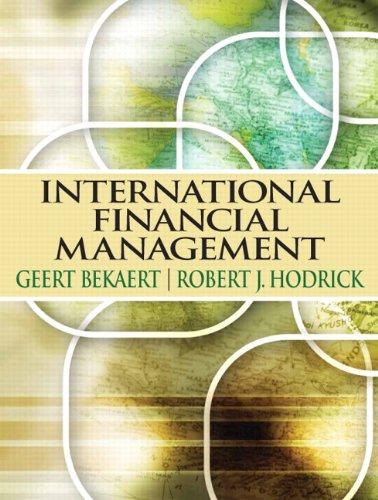Answered step by step
Verified Expert Solution
Question
1 Approved Answer
Usethetable beloo bond is a somany ear) the 4-year e table below to find the short rate that will prevail in the fourth year. Confirm

Usethetable beloo bond is a somany ear) the 4-year e table below to find the short rate that will prevail in the fourth year. Confirm that the discount factor on zero-coupon bond is a geometric average of (1 + the short rates) in the next 4 years.(10 points) Yield to Maturity (%) 5% 6 7 8 Maturity (years) 4 er, as an example, a 30-year maturity bond that is issued with a coupon rate of 4% and a yield to maturity of 8%. For simplicity, we will assume that the bond pays coupons once annually. Because of the low n rate, the bond will be issued at a price far below par value, specifically at a price of $549.69. If the bond's co d to maturity is still 8%, then its price in 1 year will rise to SS5366. Now suppose that the bond's yield to maturity falls to 7% by the end of the first year and that the investor sells the bond at $63167 after the first year If the investor's federal plus state tax rate on interest income is 38% and the combined tax rate on capital gains is 20%, what is the investor's after-tax rate of return? (10 points) 6 The bond has a 30-year maturity, an 8% coupon, and sells at an initial yield to maturity of 8%. Because the coupon rate equals yield to maturity, the bond sells at par value, or $1,000. The modified duration of the bond at its initial yield is 1 1.26 years, and its convexity is 212.4. If the bond's yield increases from 8% to 10%, the bond price will fall to $811.46, a decline of 18.85%. (10 points) a. How does the price change according to the duration rule? b. How does the price change according to the duration-with-convexity rule? Usethetable beloo bond is a somany ear) the 4-year e table below to find the short rate that will prevail in the fourth year. Confirm that the discount factor on zero-coupon bond is a geometric average of (1 + the short rates) in the next 4 years.(10 points) Yield to Maturity (%) 5% 6 7 8 Maturity (years) 4 er, as an example, a 30-year maturity bond that is issued with a coupon rate of 4% and a yield to maturity of 8%. For simplicity, we will assume that the bond pays coupons once annually. Because of the low n rate, the bond will be issued at a price far below par value, specifically at a price of $549.69. If the bond's co d to maturity is still 8%, then its price in 1 year will rise to SS5366. Now suppose that the bond's yield to maturity falls to 7% by the end of the first year and that the investor sells the bond at $63167 after the first year If the investor's federal plus state tax rate on interest income is 38% and the combined tax rate on capital gains is 20%, what is the investor's after-tax rate of return? (10 points) 6 The bond has a 30-year maturity, an 8% coupon, and sells at an initial yield to maturity of 8%. Because the coupon rate equals yield to maturity, the bond sells at par value, or $1,000. The modified duration of the bond at its initial yield is 1 1.26 years, and its convexity is 212.4. If the bond's yield increases from 8% to 10%, the bond price will fall to $811.46, a decline of 18.85%. (10 points) a. How does the price change according to the duration rule? b. How does the price change according to the duration-with-convexity rule
Step by Step Solution
There are 3 Steps involved in it
Step: 1

Get Instant Access to Expert-Tailored Solutions
See step-by-step solutions with expert insights and AI powered tools for academic success
Step: 2

Step: 3

Ace Your Homework with AI
Get the answers you need in no time with our AI-driven, step-by-step assistance
Get Started


